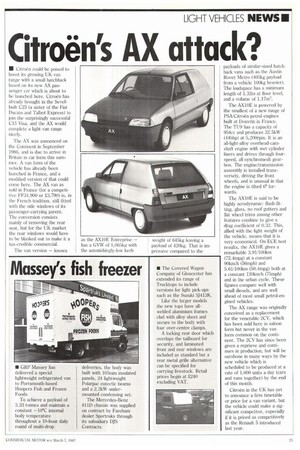Citroen's AX attack?
Page 27

If you've noticed an error in this article please click here to report it so we can fix it.
• Citroen could be poised to boost its growing UK van range with a small hatchback based on its new AX passenger car which is about to be launched here, Citroen has already brought in the Sevelbuilt C25 (a sister of the Fiat Ducat° and Talbot Express) to join the surprisingly successful C15 Visa, and the AX would complete a light van range The AX was announced on the Continent in September 1986, and is due to arrive in Britain in car form this summer. A van form of the vehicle has already been launched in France, and a modified version of that could come here. The AX van as sold in France (for a competitive FF:34.900 or £3,790) is, in the French tradition, still fitted with the side windows of its passenger-carrying parent. The conversion consists mainly of removing the rear seat, but for the UK market the rear windows would have to be blanked out to make it a tax-credible commercial.
The van version — known as the AX1OF: Entreprise — has a GVW of 1,065kg with the astonishingly-low kerb weight of 645kg leaving a payload of 420kg. That is impressive compared to the
payloads of similar-sized hatchback vans such as the Austin Rover Metro (405kg payload from a vehicle 100kg heavier). The loadspace has a minimum length of 1.32m at floor level, and a volume of 1.17m3.
The AX10E is powered by the smallest of a new range of PSA/Citroen petrol engines built at Douvrin in France. The TU9 has a capacity of 954cc and produces 32.5kW (44bhp) at 5,200rpm. It is an all-light-alloy overhead-camshaft engine with wet cylinder liners and drives through fourspeed, all-synchromesh gearbox. The engine/transmission assembly is installed transversely, driving the front wheels, and is unusual in that the engine is tilted 6° forwards.
The AX10E is said to be highly aerodynamic: flush-fitting, glass, no roof gutters and flat wheel trims among other features combine to give a drag coefficient of 0.32. This, allied with the light weight of the vehicle, means that it is very economical. On ECE test results, the AX10E gives a remarkable 3.91/100km (72.4mpg) at a constant 90km/h (56mph) and 5.61/100km (50.4mpg) both at a constant 120km/h (75mph) and in the urban cycle. These figures compare well with small diesels, and are well ahead of most small petrol-engined vehicles.
The AX range was originally conceived as a replacement for the venerable 2CV, which has been sold here in saloon form but never in the van form common on the continent. The 2CV has since been given a reprieve and continues in production, but will be outshone in many ways by the new vehicle which is scheduled to be produced at a rate of 1,000 units a day (cars and vans together) by the end of this month.
Citroen in the UK has yet to announce a firm timetable or price for a van variant, but the vehicle could make a significant competitor, especially if it is priced as competitively as the Renault 5 introduced last year.












































































































